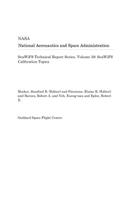
Seawifs Technical Report Series. Volume 39; Seawifs Calibration Topics
Series:
For Earth-observing satellite instruments, it was standard to consider each instrument band to have a spectral response that is infinitely narrow, i.e., to have a response from a single wavelength. The Sea-viewing Wide Field-of-view Sensor (SeaWiFS) bands, however, have nominal spectral bandwidths of 20 and 40nm. These bandwidths affect the SeaWiFS measurements on orbit. The effects are also linke
NaN
VOLUME
English
Paperback

For Earth-observing satellite instruments, it was standard to consider each instrument band to have a spectral response that is infinitely narrow, i.e., to have a response from a single wavelength. The Sea-viewing Wide Field-of-view Sensor (SeaWiFS) bands, however, have nominal spectral bandwidths of 20 and 40nm. These bandwidths affect the SeaWiFS measurements on orbit. The effects are also linked to the manner in which the instrument was calibrated and to the spectral shape of the radiance that SeaWiFS views. Currently, SeaWiFS is calibrated such that the digital counts from each instrument band are linked to the Earth-exiting radiance at an individual center wavelength. Before launch, SeaWiFS will be recalibrated so that the digital counts from each band will be linked to the Earth-exiting radiance integrated over the spectral response of that band. In this technical memorandum, the effects of the instrument calibration and the source spectral shape on SeaWiFS measurements, including the in-band and out-of-band responses, and the center wavelengths are discussed. Hooker, Stanford B. (Editor) and Firestone, Elaine R. (Editor) and Barnes, Robert A. and Yeh, Eueng-nan and Eplee, Robert E. Goddard Space Flight Center...
Price Comparison [India]
In This Series
Bestseller Manga
Trending NEWS




















